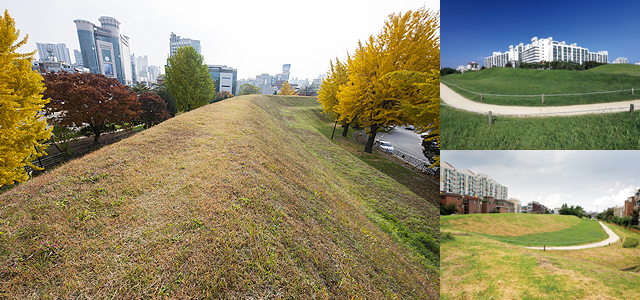PungnapToseong
- EraBaekje of the Three Kingdoms era
- StatusHistoric Site No. 11 (Jan. 21, 1963)
- Location72-1, Pungnap-dong, Songpa-gu
- Size
- Total area: 855,555 ㎡
- total length: 3.5 ㎞
- remaining length: 2.2 ㎞
- Transportation
- [Bus] 3312, 3214, 3411, 340, 341, 361
- [Subway] Cheonho Station (Pungnaptoseong Station) on Lines 5 or 8, or Gangdong-gu Office Station on Line 8

This is an earthen wall, generally called Pungnap Toseong, built on a flat area around the Hangang River. The modern-day name originated from the administrative name of its location "Pungnap-ri" (in Gwangju-gun, Gyeonggi-do) in 1963 when it was designated as a historic site. The wall has a long oval shape, spreading to north and south. It originally had a circumference of 3.7 km, but only 2.2 km of the wall remains today, as the western section facing the Hangang River collapsed due to heavy rain in 1925.
The wall was built by heaping clayish soil and sand, piling them up layer by layer. The inner wall has masonry structures to prevent collapse and the outer wall is equipped with a moat (22 meters in width) as a primary defense line and two ditches (3 meters in width each) as a secondary defense line.
The remaining wall measures five to nine meters in height and the foundation of the wall has a width of 60 meters. The estimated height of the restored wall is 15 meters and it is considered that the construction of this huge fortress might have mobilized 1.38 million people a year.
When massive flooding occurred in 1925, a big earthen jar was discovered on the sloping ground near the western wall. The jar contained two bronze tripod cauldrons. Around the area, fragments of earthenware were excavated.
In 1964, part of the layers containing relics near the northern wall was investigated by Seoul National University's research team that found black burnished pottery, cylinder-shaped pottery stands, and fragments of paddling pattern pottery.
Afterwards, in 1997, as numerous earthenware was found at a reconstruction site during the precision investigation of the wall in 1997 by Sun Moon University's team, the National Research Institute of Cultural Heritage conducted an emergency excavation.
As a result, remains from Baekje's palace, buildings, roads, and residental areas were discovered at the sites of Hyundai Riverville Apartment Complex, the reconstruction site of Gyeongdang Row Houses (Gyeongdang Historical Park), and the 197-beonji Mirae Village (Pungnap Baekje Culture Park). The tens of thousands of earthenware excavated from the sites are currently housed and exhibited by the Seoul (or Hanseong) Baekje Museum.
Pungnap Toseong is recognized as Baekje's royal fortress in consideration of the huge size of the wall, various relics excavated from the site, and the presence of royal tombs in the nearby areas including Seokchon-dong and Bangi-dong.